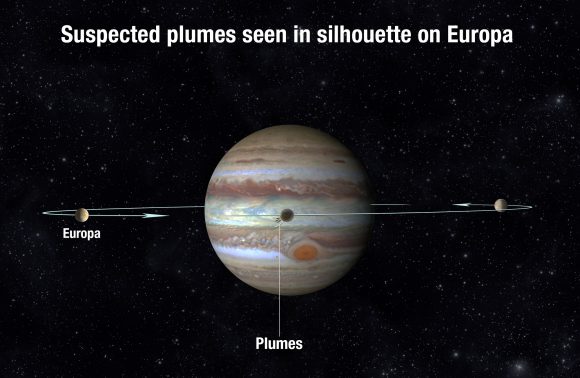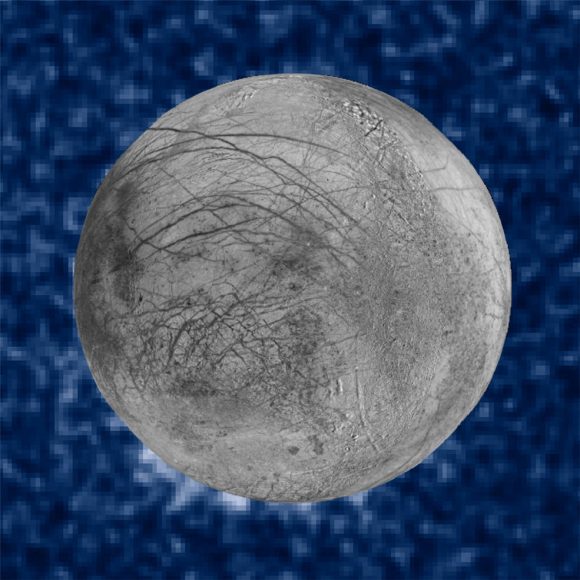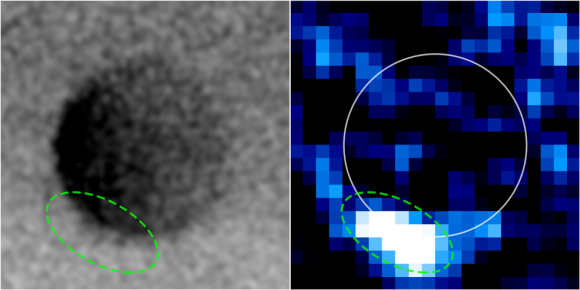Last week, on Tuesday, September 20th, NASA announced that they had made some interesting findings about Jupiter’s icy moon Europa. These were based on images taken by the Hubble Space Telescope, the details of which would be released on the following week. Needless to say, since then, the scientific community and general public have been waiting with baited breath.
Earlier today (September 26th) NASA put an end to the waiting and announced the Hubble findings during a NASA Live conference. According to the NASA panel, which was made up of members of the research team, this latest Europa-observing mission revealed evidence of plumes of saline water emanating from Europa’s surface. If true, this would mean that the moon’s subsurface ocean would be more accessible than previously thought.
Using Hubble’s Space Telescope Imaging Spectrograph (STIS) instrument, the team conducted observations of Jupiter and Europa in the ultra-violet spectrum over the course of 15 months. During that time, Europa passed in front of Jupiter (occulted the gas giant) on 10 separate occasions.
And on three of these occasions, the team saw what appeared to be plumes of water erupting from the surface. These plumes were estimated to be reaching up to 200 km (125 miles) from the southern region of Europa before (presumably) raining back onto the surface, depositing water ice and material from the interior.
The purpose of the observation was to examine Europa’s possible extended atmosphere (aka. exosphere). The method the team employed was similar to the one used to detect atmospheres around extra-solar planets. As William Sparks of the Space Telescope Science Institute (STScI) in Baltimore (and the team leader), explained in a NASA press release:
“The atmosphere of an extrasolar planet blocks some of the starlight that is behind it. If there is a thin atmosphere around Europa, it has the potential to block some of the light of Jupiter, and we could see it as a silhouette. And so we were looking for absorption features around the limb of Europa as it transited the smooth face of Jupiter.”
When they looked at Europa using this same technique, they noted that small patches on the surface were dark, indicating the absorption of UV light. This corresponded to previous work done by Lorenz Roth (of the Southwest Research Institute) and his team of researchers in 2012. At this time, they detected evidence of water vapor coming from Europa’s southern polar region.

As they indicated in a paper detailing their results – titled “Transient Water Vapor at Europa’s South Pole” – Roth’s team also relied on UV observations made using the Hubble telescope. Noting a statistically coincident amount of hydrogen and oxygen emissions, they concluded that this was the result of ejected water vapor being broken apart by Jupiter’s radiation (a process known as radiolysis).
Though their methods differed, Sparks and his research team also found evidence of these apparent water plumes, and in the same place no less. Based on the latest information from STIS, most of the apparent plumes are located in the moon’s southern polar region while another appears to be located in the equatorial region.
“When we calculate in a completely different way the amount of material that would be needed to create these absorption features, it’s pretty similar to what Roth and his team found,” Sparks said. “The estimates for the mass are similar, the estimates for the height of the plumes are similar. The latitude of two of the plume candidates we see corresponds to their earlier work.”
Another interesting conclusion to come from this and the 2012 study is the likelihood that these water plumes are intermittent. Basically, Europa is tidally-locked world, which means the same side is always being presented to us when it transits Jupiter. This occus once every 3.5 days, thus giving astronomers and planetary scientists plenty of viewing opportunities.

But the fact that plumes have been observed at some points and not others would seem to indicate that they are periodic. In addition, Roth’s team attempted to spot one of the plume’s observed by Sparks and his colleagues a week after they reported it. However, they were unable to locate this supposed water source. As such, it would appear that the plumes, if they do exist, are short-lived.
These findings are immensely significant for two reasons. On the one hand, they are further evidence that a warm-water, saline ocean exists beneath Europa’s icy surface. On the other, they indicate that any future mission to Europa would be able to access this salt-water ocean with greater ease.
Ever since the Galileo spacecraft conducted a flyby of the Jovian moon, scientists have believed that an interior ocean is lying beneath Europa’s icy surface – one that has between two and three times as much water as all of Earth’s oceans combined. However, estimates of the ice’s thickness range from it being between 10 to 30 km (6–19 mi) thick – with a ductile “warm ice” layer that increases its total thickness to as much as 100 km (60 mi).
Knowing the water periodically reaches the surface through fissures in the ice would mean that any future mission (which would likely include a submarine) would not have to drill so deep. And considering that Europa’s interior ocean is considered to be one of our best bets for finding extra-terrestrial life, knowing that the ocean is accessible is certainly exciting news.

And the news is certainly causing its fair share of excitement for the people who are currently developing NASA’s proposed Mission to Europa, which is scheduled to launch sometime in the 2020s. As Dr. Cynthia B. Phillips, a Staff Scientist and the Science Communications Lead for the Europa Project, told Universe Today via email:
“This new discovery, using Hubble Space Telescope data, is an intriguing data point that helps lend support to the idea that there are active plumes on Europa today. While not an absolute confirmation, the new Sparks et al. result, in combination with previous observations by Roth et al. (also using HST but with a different technique), is consistent with the presence of intermittent plumes ejecting water vapor from the Southern Hemisphere of Europa. Such observations are difficult to perform from Earth, however, even with Hubble, and thus these results remain inconclusive.
“Confirming the presence or absence of plumes on Europa, as well as investigating many other mysteries of this icy ocean world, will require a dedicated spacecraft in the Jupiter system. NASA currently plans to send a multiple-flyby spacecraft to Europa, which would make many close passes by Europa in the next decade. The spacecraft’s powerful suite of scientific instruments will be able to study Europa’s surface and subsurface in unprecedented detail, and if plumes do exist, it will be able to observe them directly and even potentially measure their composition. Until the Europa spacecraft is in place, however, Earth-based observations such as the new Hubble Space Telescope results will remain our best technique to observe Jupiter’s mysterious moon.”
Naturally, Sparks was clear that this latest information was not entirely conclusive. While he believes that the results were statistically significant, and that there were no indications of artifacts in the data, he also emphasized that observations conducted in the UV wavelength are tricky. Therefore, more evidence is needed before anything can be said definitively.
In the future, it is hoped that future observation will help to confirm the existence of water plumes, and how these could have helped create Europa’s “chaos terrain”. Future missions, like NASA’s James Webb Space Telescope (scheduled to launch in 2018) could help confirm plume activity by observing the moon in infrared wavelengths.
As Paul Hertz, the director of the Astrophysics Division at NASA Headquarters in Washington, said:
“Hubble’s unique capabilities enabled it to capture these plumes, once again demonstrating Hubble’s ability to make observations it was never designed to make. This observation opens up a world of possibilities, and we look forward to future missions — such as the James Webb Space Telescope — to follow up on this exciting discovery.”
Other team members include Britney Schmidt, an assistant professor at the School of Earth and Atmospheric Sciences at Georgia Institute of Technology in Atlanta; and Jennifer Wiseman, senior Hubble project scientist at NASA’s Goddard Space Flight Center in Greenbelt, Maryland. Their work will be published in the Sept. 29 issue of the Astrophysical Journal.
And be sure to enjoy this video by NASA about this exciting find:
Further Reading: NASA Live


/me googles “Iceland Geysers” …
Reads about “Marco Evaristti” and geysers …
Maybe he’ld volunteer to fly to Europa.
Elon’ll get there 1st 🙂
The sooner the better please. I ain’t getting any younger.
I love the idea of scooping some of the material from a plume. That avoids all the risk of contamination we would get from landing and drilling. There is a slight chance of ending a voyage of billions of miles by being smacked by a Europan fish. That would be a tad undiginfied.